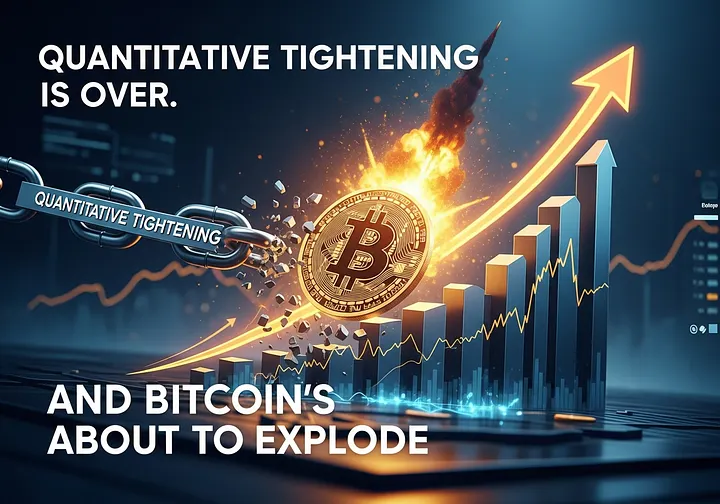Last time they did this, Bitcoin surged by 1400%.
Author: Alertforalpha
Translation: Blockchain in Plain Language

Quantitative Tightening (QT) is over.
The Federal Reserve will stop reducing its $6.6 trillion balance sheet on December 1. When did they last do this? Bitcoin didn't just rise—it skyrocketed. Everything went up: stocks, gold, altcoins, and more.
What do QE and QT really mean?
When the Federal Reserve prints money, it is called Quantitative Easing (QE). They buy bonds, injecting cash into the system—risk assets go wild.
Quantitative Tightening (QT) is the opposite. The Federal Reserve lets bonds mature—money leaves the system. Credit tightens. Prices fall. The market crashes.
This situation has persisted for over a decade.
Since 2008, the Federal Reserve has gone through several rounds of QE—injecting trillions of dollars and keeping interest rates low. In 2019, cash ran dry. Overnight, the repo market nearly froze. The Federal Reserve intervened, taking emergency measures similar to QE. Then came the COVID-19 pandemic in 2020. The Federal Reserve doubled down on comprehensive QE—the market went crazy. By 2022, inflation reached its highest point in a generation. The Federal Reserve reversed its policy—aggressive QT and rapid interest rate hikes.
Whenever the Federal Reserve tightens, something always crashes. Whenever it loosens, assets skyrocket.
What is happening now?
Every month, $40 billion worth of bonds mature. The government pays the Federal Reserve. During QT, the Federal Reserve lets this money leave the system—it does not reinvest in bonds.
But starting December 1, all of this will stop. The Federal Reserve will reinvest the maturing funds into bonds. This changes everything.
When QT ends, QE does not automatically begin—but when you stop pulling money out and start putting it back in, that is "invisible" QE. As the Federal Reserve resumes purchasing bonds:
Bond prices rise
Yields fall
Investors chase higher-risk assets—stocks, Bitcoin, everything.
Don't forget what happened last time
After the outbreak of COVID-19, the Federal Reserve launched a $700 billion QE program and cut interest rates to zero. From March 2020 to December 2021, the S&P 500 soared over 2000 points. By the end of 2021, it had risen more than 1400%.
Then the Federal Reserve turned off the lights. QT began in June 2022. Liquidity disappeared. A bear market followed.
QE and QT are not just technical policy tools—they are the market's "on/off" switches.
We are experiencing a rule change period
Interest rates are falling. QT is ending. The system is shifting to more liquidity. At any moment, the Federal Reserve could inject funds again.
What does this mean for Bitcoin?
Bitcoin is the purest reflection of global liquidity. No earnings reports. No price-to-earnings ratios. No company buybacks. Just a tick-by-tick indicator of how money flows.
During the QE of the COVID-19 pandemic, Bitcoin reached $69,000. Now, the situation in the market is even larger:
The Federal Reserve's balance sheet is larger
The debt burden is heavier
The interest burden has doubled
When liquidity shifts— and it will—risk assets will react violently. Even under severe QT, stocks and Bitcoin set new highs. So, what will happen when the Federal Reserve turns the taps back on?
That big question
Will we see a new bull market while welcoming the loosest monetary policy in years? Or, more likely, are things about to get crazy?
Things always happen the same way: The Federal Reserve injects massive amounts of money into the system. The market melts down. The shock fades. Everyone thinks they have it figured out. Then—the cycle starts again.
Article link: https://www.hellobtc.com/kp/du/11/6113.html
Source: https://medium.com/@alertforalpha/quantitative-tightening-is-over-and-bitcoins-about-to-explode-2b127451c132
免责声明:本文章仅代表作者个人观点,不代表本平台的立场和观点。本文章仅供信息分享,不构成对任何人的任何投资建议。用户与作者之间的任何争议,与本平台无关。如网页中刊载的文章或图片涉及侵权,请提供相关的权利证明和身份证明发送邮件到support@aicoin.com,本平台相关工作人员将会进行核查。




